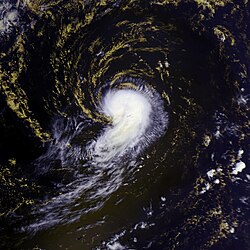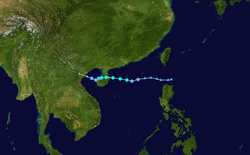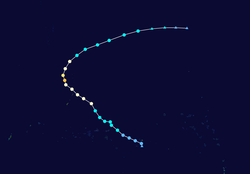Wipha 18 sept 2007 044Z cropped
Super Typhoon Wipha was approaching the coast of China on the afternoon of September 18, 2007, when the Moderate Resolution Imaging Spectroradiometer (MODIS) on NASA’s Aqua satellite captured this photo-like image. At the time (12:40 p.m. local time, 4:40 UTC), Wipha had winds between 250 kilometers per hour (155 miles per hour or 135 knots) and 240 km/hr (150 mph or 130 knots), making it a strong Category 4 storm and a Super Typhoon (a typhoon with winds of at least 130 knots). The storm weakened shortly after this image was taken and was forecast to weaken further before making landfall over the densely populated East China coast late on September 18 or early on September 19.
Though the storm was weakening, it was anticipated to be the strongest storm to hit China in a decade, reported Xinhua, China’s news agency. In preparation for the storm, the government evacuated about two million people in three provinces, said Xinhua. The storm had already started to soak Taiwan with heavy rains by the time this image was taken. The spiraling bands of rain clouds cover the island in this image, though the dark, well-defined eye remains offshore to the north. The image also reveals just how large Wipha was. Including its outer bands, which stretch from the Philippines (visible in the large image) in the south to the East China coast in the north, Wipha sprawls over several hundred kilometers.
The high-resolution image provided above is at MODIS’ full spatial resolution (level of detail) of 250 meters per pixel. The MODIS Rapid Response System provides this image at additional resolutions.| Diese Datei ist gemeinfrei (public domain), da sie von der NASA erstellt worden ist. Die NASA-Urheberrechtsrichtlinie besagt, dass „NASA-Material nicht durch Urheberrecht geschützt ist, wenn es nicht anders angegeben ist“. (NASA-Urheberrechtsrichtlinie-Seite oder JPL Image Use Policy). |  | |
 |
Warnung:
|
Relevante Bilder
Relevante Artikel
Pazifische Taifunsaison 2007Die Pazifische Taifunsaison 2007 dauerte vom 1. Januar bis 31. Dezember 2007, obwohl sich die meisten Zyklone im nordwestlichen Pazifischen Ozean zwischen Mai und November bilden. Tropische Stürme, die sich auf der Nordhalbkugel im Pazifischen Ozean westlich der Datumsgrenze bildeten, nennt man Taifune. Die sich 2007 im Pazifischen Ozean östlich der Datumsgrenze und nördlich des Äquators gebildeten Hurrikane sind Gegenstand der Pazifischen Hurrikansaison 2007. Tropische Stürme, die sich im Bereich des westlichen Pazifischen Ozeanes bilden, werden durch die Japan Meteorological Agency (JMA) mit einem Namen versehen. Tropische Tiefdruckgebiete in diesem Becken erhalten das Suffix „W“ zu der laufenden Nummerierung durch das Joint Typhoon Warning Center. Tropische Systeme, die sich im Verantwortungsbereich der Philippinen bilden oder in diesen hineinwandern, erhalten einen Namen durch die Philippine Atmospheric, Geophysical and Astronomical Services Administration (PAGASA). Dies kann dazu führen, dass Stürme zwei verschiedene Namen haben. .. weiterlesen










































